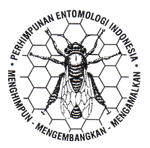Biologi dan kelimpahan tungau merah Tetranychus sp. (Acari: Tetranychidae) pada dua kultivar jarak pagar (Jatropha curcas)
DOI:
https://doi.org/10.5994/jei.11.1.34Keywords:
Jatropha curcas, predatory mite, spider miteAbstract
Red spider mite Tetranychus sp. is one of the most important pests attacking leaves of Jatropha curcas. The objective of this study was to elucidate life history parameters and abundance of spider mite on two J. curcas cultivars. Field studies were carried out in BALITTRI Pakuwon Sukabumi, and laboratory experiments were conducted at the Department of Plant Protection, Bogor Agricultural University, from June to November 2008. Cultivars significantly affected several life history parameters of the spider mite. Spider mite reared on IP1-P cultivar have longer oviposition period and higher fecundity than those on IP2-P (7.00 days and 25.56 eggs against 5.00 days and 10.00 eggs). The sex ratio of spider mite was 3.2 : 1 on IP1-P and 2.5 : 1 on IP2-P. Intrinsic rate of increase was also higher on IP1-P. However, field studies indicated that the spider mite were less abundant on this cultivar. These might be due to the presence of other arthropods which were higher on IP1-P. In general, the highest population of spider mite occurred in August and the lowest in October–November. Predatory mite Family Phytoseiidae was found associated with spider mite, however its role as natural control agent was not significant.
Downloads
Downloads
Published
How to Cite
Issue
Section
License
Authors who publish with this journal agree to the following terms:
- Authors retain copyright and grant the journal right of first publication with the work simultaneously licensed under a Creative Commons Attribution 4.0 International License that allows others to share the work with an acknowledgement of the work's authorship and initial publication in this journal.
- Authors are able to enter into separate, additional contractual arrangements for the non-exclusive distribution of the journal's published version of the work (e.g., post it to an institutional repository or publish it in a book), with an acknowledgement of its initial publication in this journal.
- Authors are permitted and encouraged to post their work online (e.g., in institutional repositories or on their website) prior to and during the submission process, as it can lead to productive exchanges, as well as earlier and greater citation of published work (See The Effect of Open Access).








